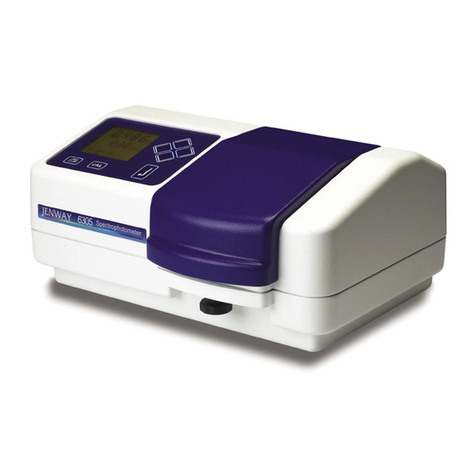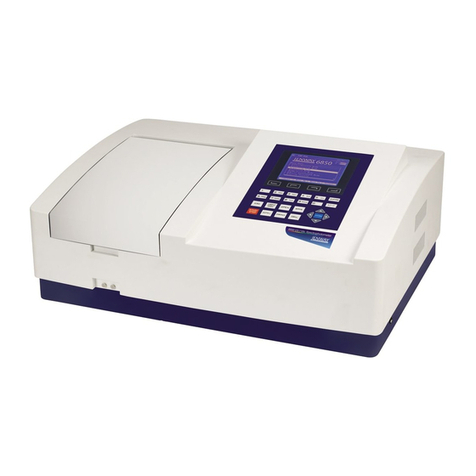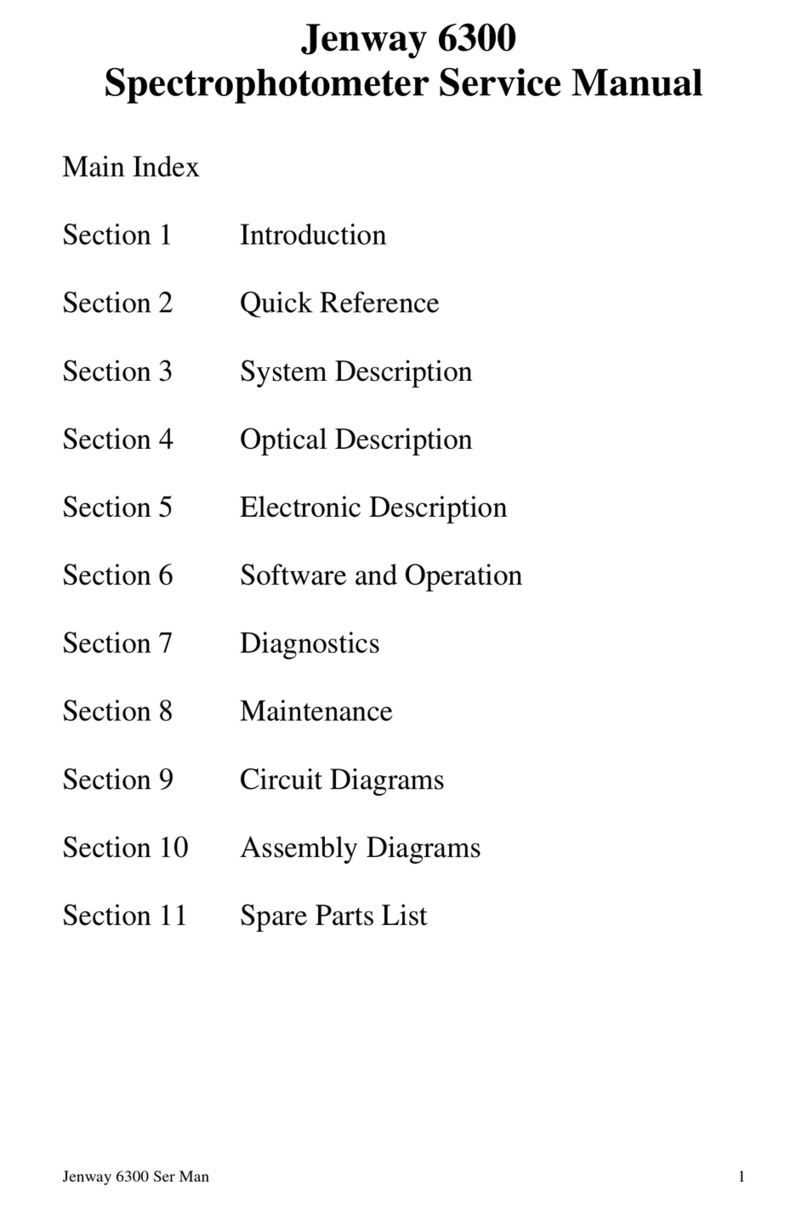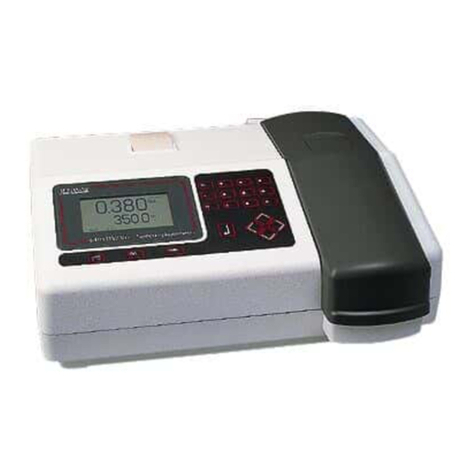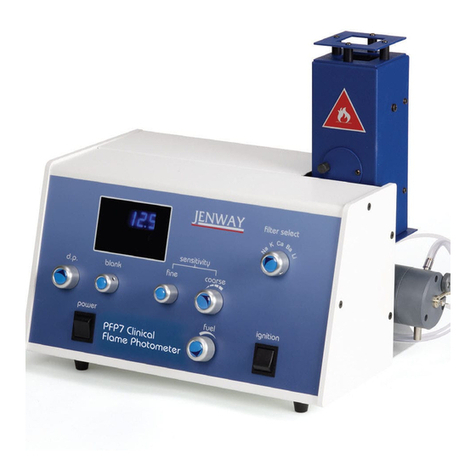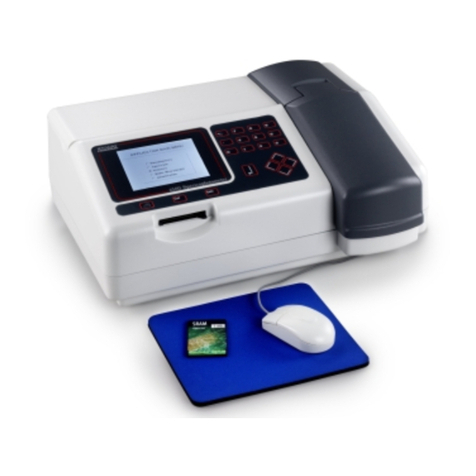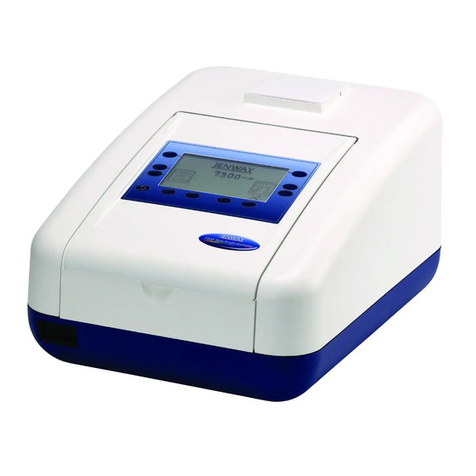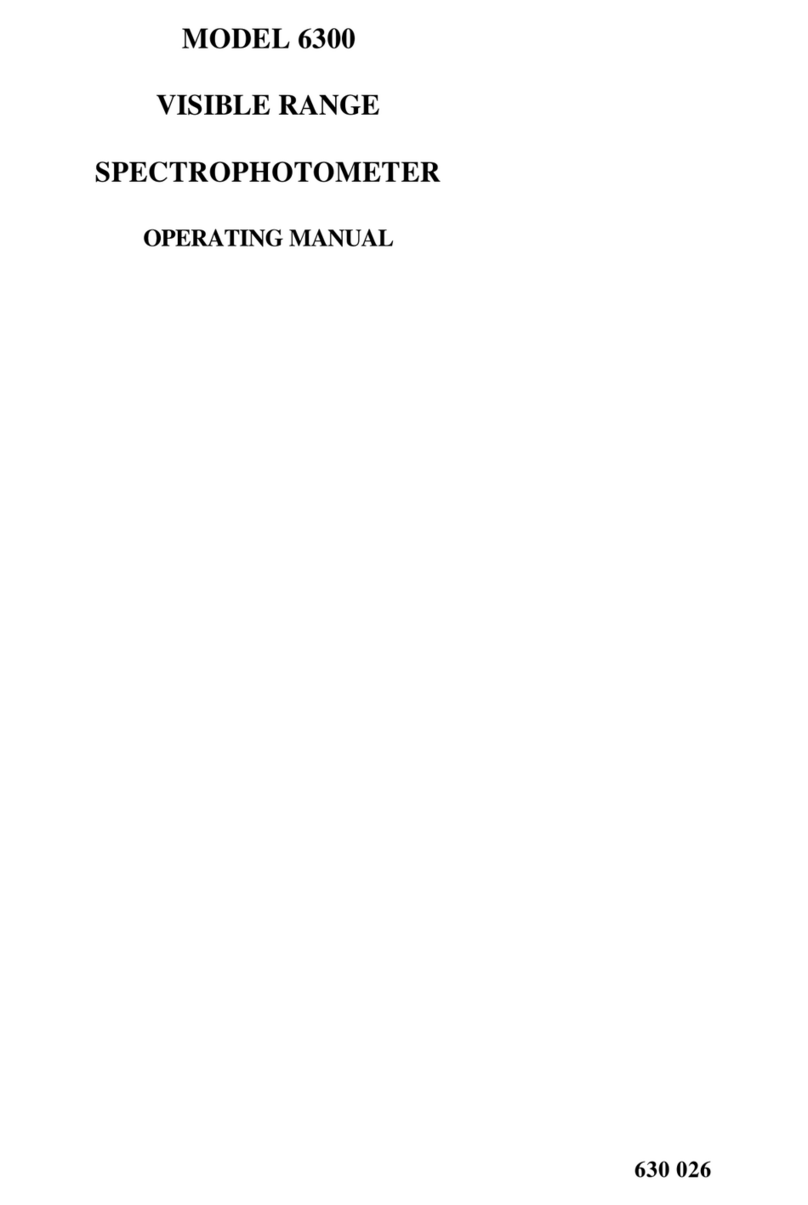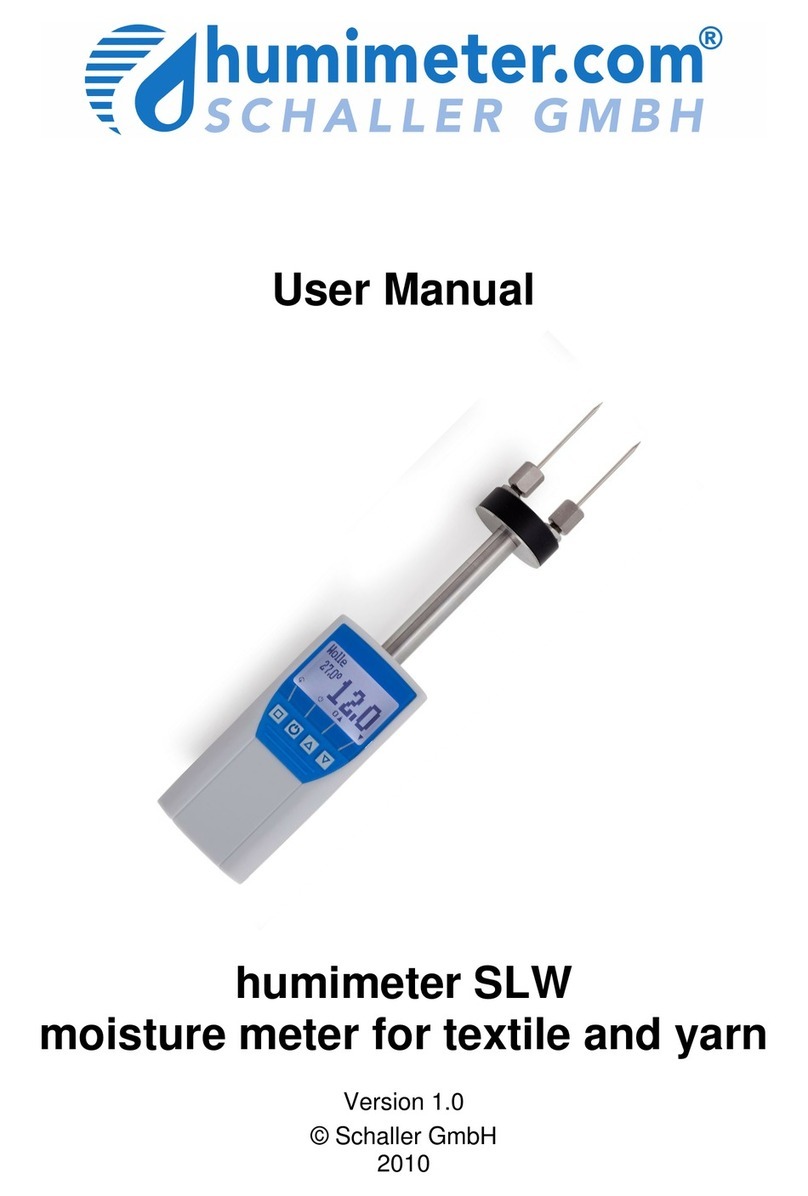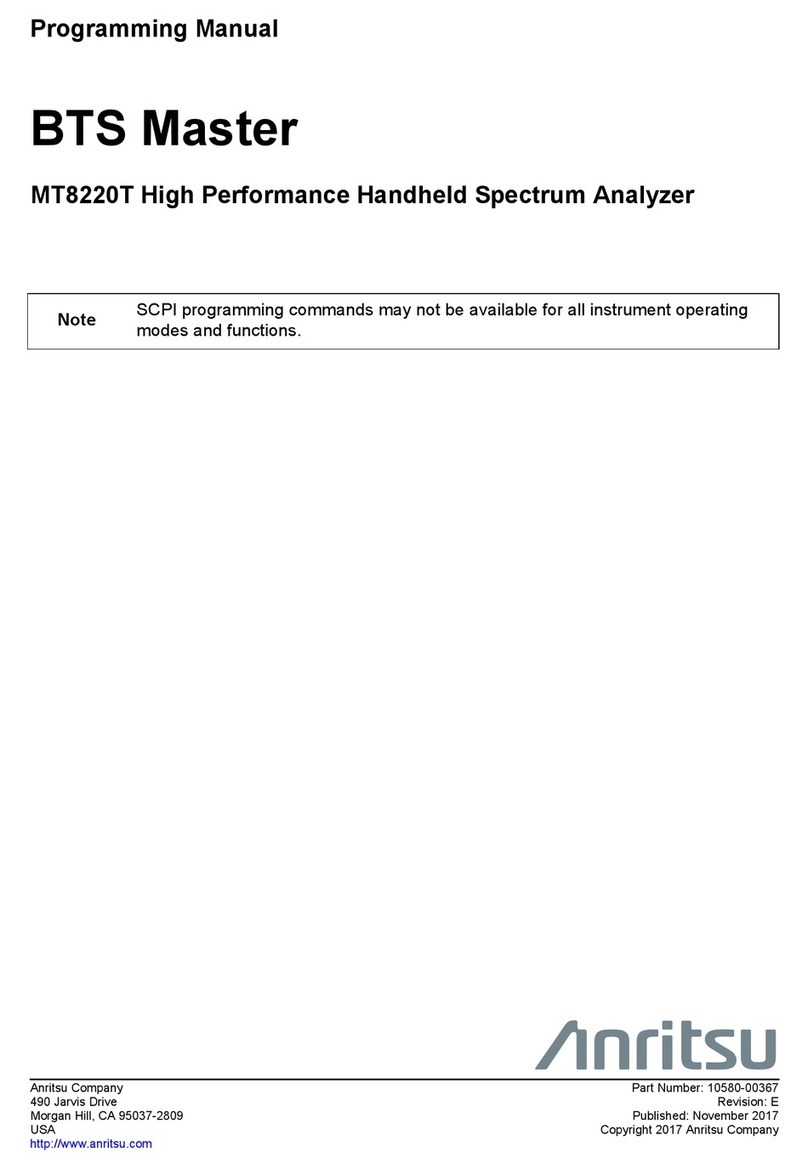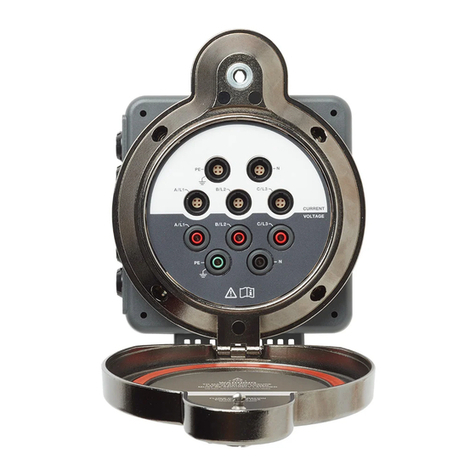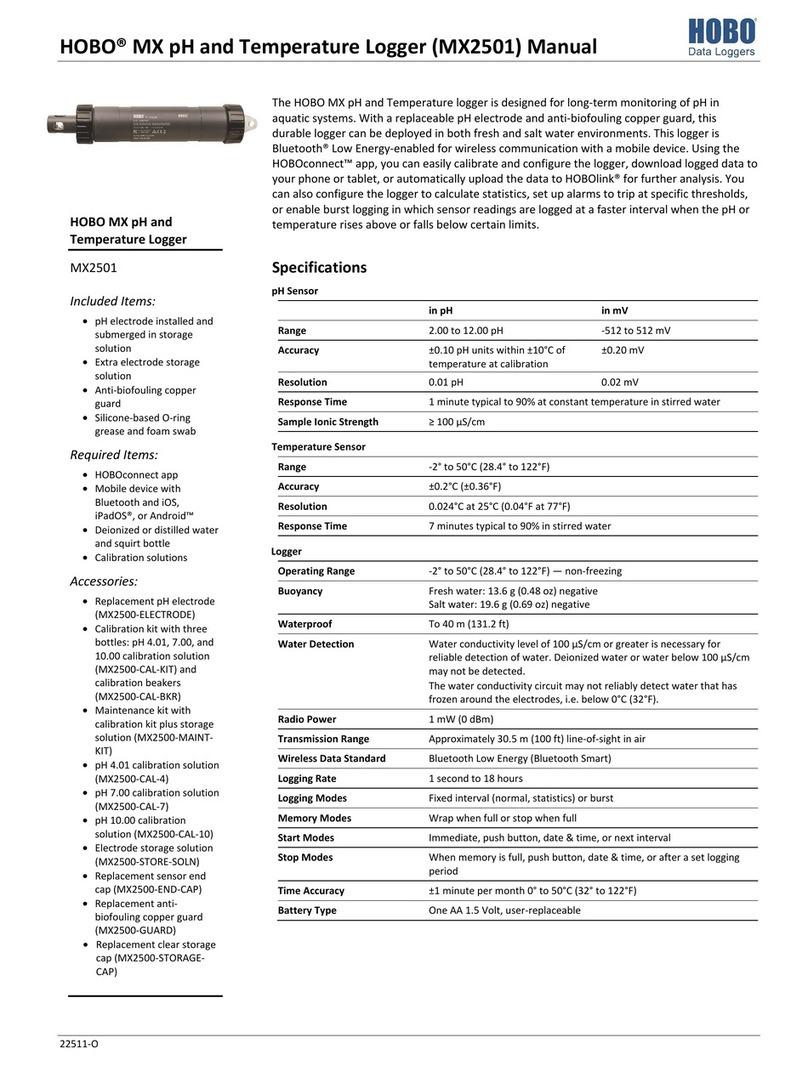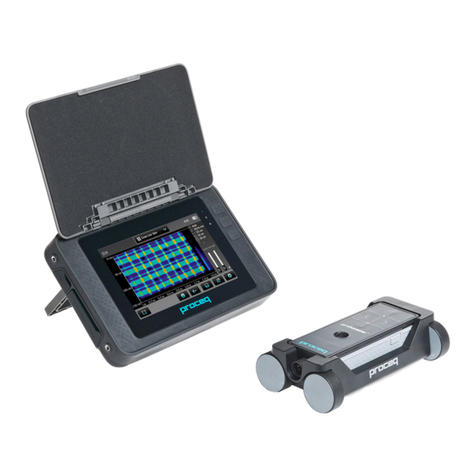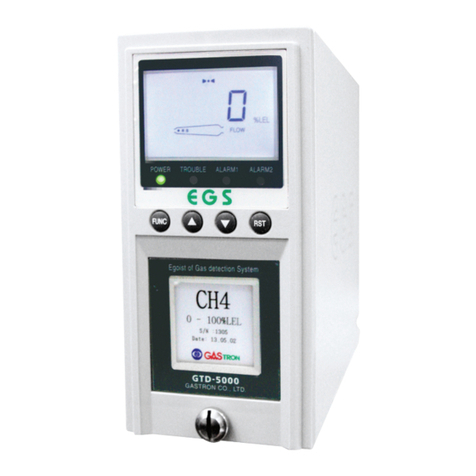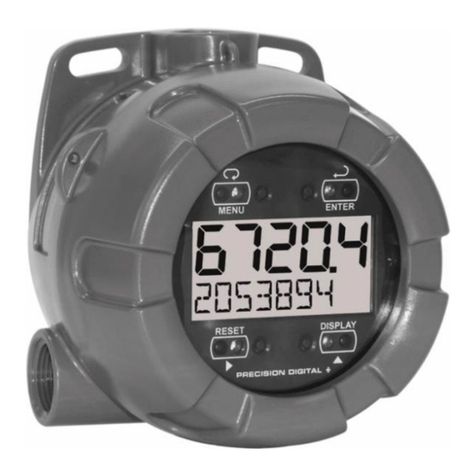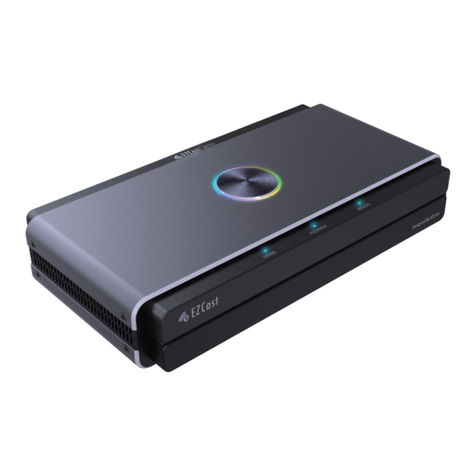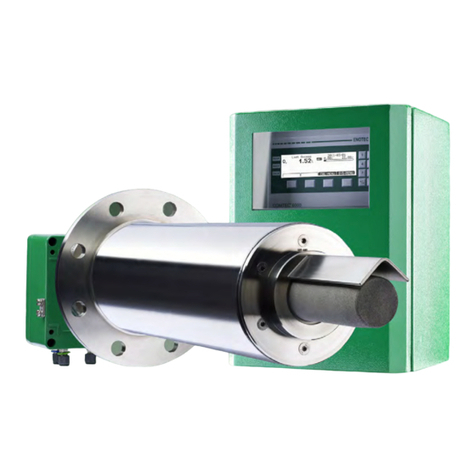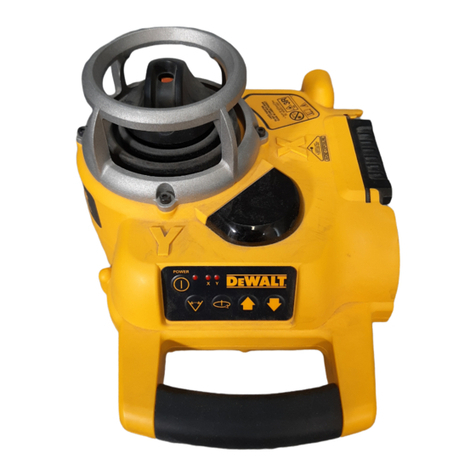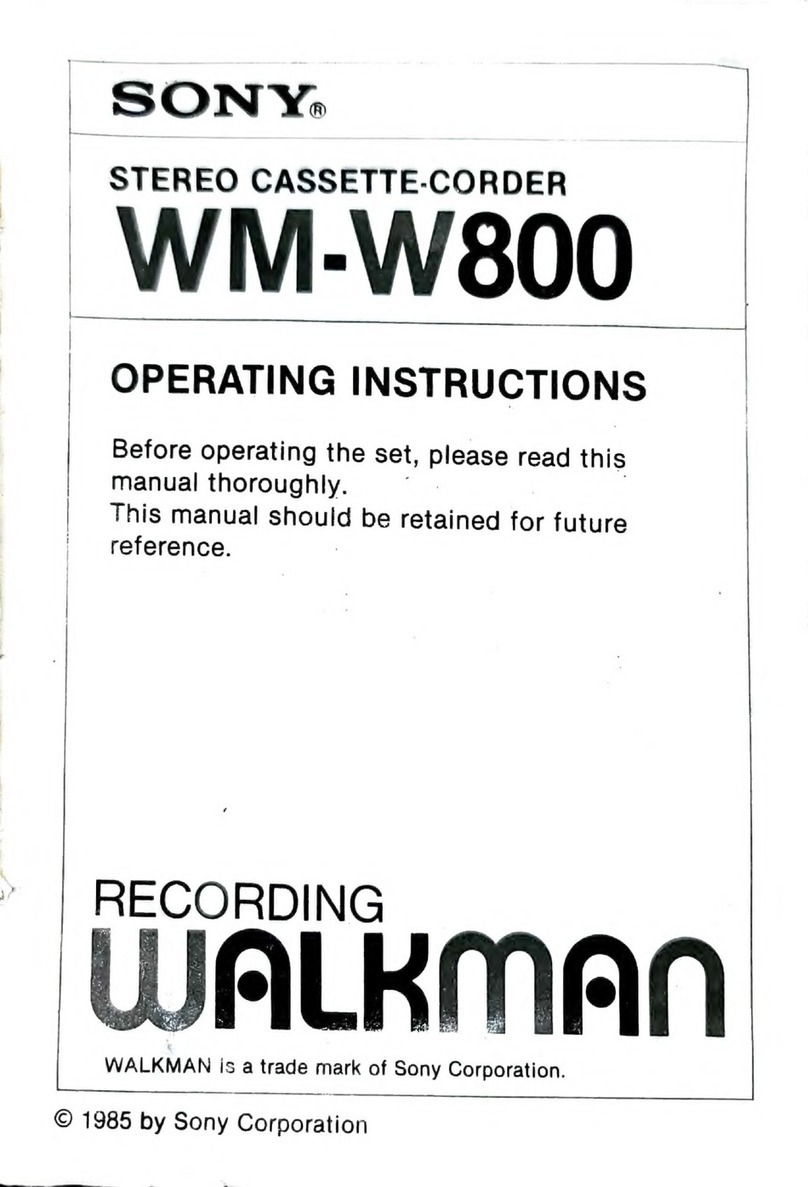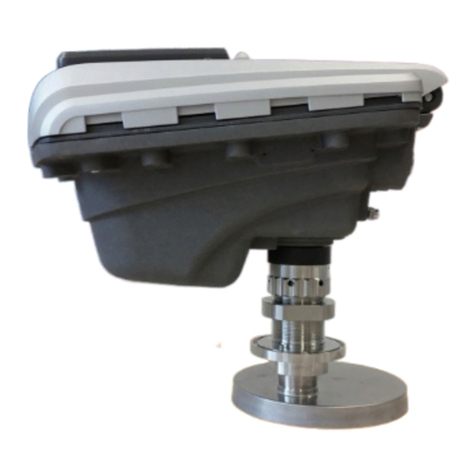jenway 3505 User manual

350 550/REV A/03-03
Model 3505
pH/mV/Temperature Meter
Operating Manual

SAFETY
Please read this information carefully prior to installing or using this equipment.
1. The unit described in this manual is designed to be operated only by trained personnel. Any adjust-
ments, maintenance and repair must be carried out as defined in this manual, by a person qualified to
be aware of the hazards involved.
2.Itisessentialthatbothoperatingandservicepersonnelemployasafesystemofwork,inadditionto
the detailed instructions specified in this manual.
3. References should always be made to the Health & Safety data supplied with any chemicals used.
Generally accepted laboratory procedures for safe handling of chemicals should be employed.
4. If it is suspected that safety protection has been impaired in any way, the unit must be made
inoperative and secured against any intended operation. The fault condition should immediately be
reported to the appropriate servicing authority.
350 550/REV A/03-03

Model 3505
pH/mV/Temperature Meter
Operating Manual
Contents
Section 1 Introduction
Instrument Description 1.1
Instrument Specifications 1.2
Section 2 Installation
Unpacking 2.1
Installation 2.2
Displays/Controls 2.3
Inputs/Outputs 2.4
Section 3 Operation
Theory of pH Measurement 3.1
pH Measurement 3.2
Preparation of Buffer Solution 3.3
Solution Temperature Values 3.4
Good Practice Guidelines 3.5
pH Calibration Using Buffers 3.6
Performing Measurements 3.7
Section 4 Maintenance
General 4.1
Cleaning/Re-conditioning Combination
Electrodes 4.2
Section 5 Optional Accessories
Optional Accessories 5.1
Spares 5.2
Section 6 Troubleshooting & Functional Checks
Troubleshooting 6.1
Functional Checks 6.2
EC Declaration of Conformity
350 550/REV A/03-03

Section 1
Introduction
1.1 Instrument Description
The Model 3505 is a general purpose, laboratory pH/mV meter that uses rotary controls for mode
selection, pH calibration and manual temperature adjustment. Automatic Temperature
Compensation can be achieved by use of the ATC probe, which will enable the user to perform
temperature measurements within the range of 0 to 100°C.
The Model 3505 has a liquid crystal display and is battery operated. The use of an optional power
supply permits the unit to be operated from the a.c. mains supply.
1.2 Instrument Specifications
Range Resolution
-2.00 to 16.00pH 0.01pH
-1999 to +1999mV 1mV
Accuracy: pH: ±0.02pH
Millivolts: ±1mV
Temperature: ±0.5°C
Input Impedance: >1012ohms
Temperature
Compensation: Manual: -10 to 105°C 0.1°C
Automatic: 0 to 100°C 0.1°C
Calibration: Manual
Display: 25mm LCD
Power: 9V Battery (MN1604, PP3 or equivalent)
Outputs: Analogue buffered electrode potential
Size: 250(L) x 210(W) x 55(D)mm
Weight: 850g
350 550/REV A/03-03
1

Section 2
Installation
2.1 Unpacking
Remove the Model 3505 from the packaging and ensure the following items are included:
1. Model 3505 pH/mV/Temperature meter
2. Epoxy bodied combination pH electrode (924 001)
3. ATC probe (027 500)
4. Electrode holder
5. 4, 7 and 10pH buffer sachets
6. BNC shorting plug (009 146)
7. Battery (PP3)
8. Condensed operating instructions (350 551)
9. Instruction manual (350 550)
Any shortages or damage should be reported immediately to the Manufacturer or your local
Distributor.
2.2 Installation
350 550/REV A/03-03
2
The Model 3505 is supplied ready to use. Connect the ATC (if required) and the pH electrode to the
rear panel Temp and pH sockets.
The electrode stand requires minimal assembly (refer to the diagram below).
Fig. 2.2.1 - Electrode Holder Assembly
4
1
2
3

2.3 Displays/Controls
Fig. 2.3.1 - Displays/Controls
1. Display Provides direct readout of pH, millivolts, temperature of
samples and standards and low battery indication.
2. Function Used for selection of mode of operation.
Switch Off - power off.
pH - pH measurement based on last calibration (the adjustment
controls have no function).
pH Cal - pH display based on settings of the adjustment
controls for buffer and slope.
°C - displays the measured temperature if an ATC probe is
connected, or the manually adjusted temperature (set by the
Slope/Manual temperature control).
mV - displays the electrode potential in mV.
3. Buffer Used to balance out the electrode offset between the pH
measurement cell and reference. This should be set with the
electrode immersed in pH7 buffer. This control adjusts the electrode effect
between -60mV to +60mV.
4. Slope Used to compensate for the variable sensitivity of pH
electrodes. As the electrodes age their sensitivity decreases
and this control is used to compensate for this. This control
adjusts the slope between 75% and 125% of Nernst.
5. Manual Temp When the °C mode is selected (without the ATC probe connected)
this control allows the compensation temperature to be set on the
display. This control becomes inoperative during use of the
ATC probe. The display will show the measured temperature if an ATC
probe is connected, or the manually adjusted temperature (set by the Slope/
Manual Temp control).
350 550/REV A/03-03
3

2.4 Inputs/Outputs
Fig. 2.4.1 - Rear Panel Layout
1. Ref Socket 2mm pin socket. Connection socket for a separate reference
electrode. When performing measurements with some pH and
Ion Selective electrodes a separate reference electrode is needed.
2. pH Socket BNC type socket which allows combination pH or redox
electrodes to be used.
3. Temp Socket 8 pin mini DIN socket. This allows the Automatic Temperature
Compensation (ATC) probe (027 500) to be connected.
4. Analog Out 2 x 4mm sockets. Buffered electrode potential.
5. Power In AC 9V I/P socket. 2.1 x 5.5mm socket allowing the optional power
supply to be connected to the instrument. Refer Section 5, Optional
Accessories.
6 Battery Housing for battery (types PP3 or MN1604).
Compartment
350 550/REV A/03-03
4

Section 3
Operation
3.1 Theory of pH Measurement
pH is a unit of measurement which defines the degree of acidity or alkalinity of a solution. It is
usually measured on a scale of 0 to 14. The pH value quantifies the degree of hydrogen ion activity
of an acid or a base.
The internationally accepted symbol, pH, is derived from “p”, the mathematical symbol of the
negative logarithm and “H”, the chemical symbol for Hydrogen. The pH value is the negative
logarithm of Hydrogen ion activity as shown in the mathematical relationship pH=-log[H+].
The pH value of a solution is directly related to the ratio of the hydrogen ion [H+] and the hydroxyl ion
[OH-] concentrations. If the concentration of H+is greater than OH-, the material is acidic and has a
pH value of less than 7. Conversely, if the concentration of OH-is greater than H+ the material is
basic, with a pH value greater than 7. If the concentrations of H+and OH-are equal the material is
neutral with a pH value of 7.
It can, therefore, be seen that pH is a measurement of both acidity and alkalinity, even though by
definition it is a selective measurement of hydrogen ion activity. The logarithmic relationship
between hydrogen ion concentration and the pH unit means that a change of one pH unit
represents a ten-fold change in hydrogen ion concentration.
3.2 pH Measurement
pH can be measured by using either pH papers/indicators or a pH meter, dependent on the level of
accuracy required. pH papers or indicators change colour as the pH level varies. These can be
used as a guide to the pH colour level, but can be limited in accuracy and difficult to interpret
correctly in murky or coloured samples.
For greater accuracy the use of a high impedance pH meter is recommended, together with a pH
measuring electrode and reference electrode.
Each component part of the measurement system can be described as follows:
a) the pH meter - is a high impedance amplifier used to accurately measure the minute
electrode voltages produced. The pH meter will display the results directly in pH units on either an
analogue or digital display. Voltages can also be read for special applications, ORP (Oxidation-
Reduction Potential) measurements or with Ion Selective Electrodes.
b) the pH electrode - is a hydrogen ion sensitive glass bulb, with a millivolt output that varies with
the changes in the relative hydrogen ion concentration inside and outside of the bulb. The pH
electrode has very high internal resistance, making the voltage change with pH difficult to measure.
The input impedance of the pH meter and leakage resistances are therefore important factors.
c) the reference electrode - these cells consist of an internal element, usually a silver/silver
chloride wire, electrolyte (KCl) and a liquid junction. The liquid junction provides a leak path for the
internal electrolyte to “weep” into the sample chamber and provide an electrical contact with the
liquid to be measured. If the liquid junction is inefficient then measurement will be inaccurate. It is
common for the reference electrode to be incorporated into the pH electrode. It is then called a
combination electrode. The Model 3505 is supplied with a combination electrode.
350 550/REV A/03-03
5

The voltage developed by each individual pH electrode in the presence of a known hydrogen ion
concentration is theoretically predictable, but in practise deviations from the theoretical value can be
expected. These deviations will change slowly during the life of an electrode. It is therefore essential
to routinely calibrate the system using solutions with a known and constant pH value. These
solutions are called buffers.
3.3 Preparation of Buffer Solutions
Care must be taken in the preparation of all buffer solutions. The correct quantity of distilled or
deionised water should be used when preparing the solutions. For accurate and repeatable results
it is essential to follow the manufacturers instructions carefully.
3.4 Solution Temperature Values
The value of all buffer solutions varies with solution temperature. For accurate calibration of
electrodes using buffer solutions, it is necessary to measure the temperature of the buffer solution
being used. The unit should then be calibrated to the corrected pH value. Manufacturers of buffer
powders and solutions will provide a table of values at varying temperatures for their buffers.
NOTE: Buffer solutions will contaminate with exposure to air and should be stored in
airtight containers when not in use. Used solution should be discarded and not
returned to the container as this will cause contamination.
For best results fresh solutions should be prepared prior to calibration.
350 550/REV A/03-03
6

3.5 Good Practice Guidelines
The types of electrodes available are many and various. For the majority of tests carried out on
aqueous solutions, with a reasonable ionic strength; at ambient temperatures and with limited use
in strongly acidic or alkaline solutions, the standard glass or epoxy bodied combination electrode is
ideal.
For other applications a more suitable pH/reference electrode pair may be required; details or
advice supplied on request.
The following general guidelines indicate the care and maintenance required for the three main
groups of electrodes (Combination, Reference and pH). For more detailed advice on specific
electrodes contact the electrode manufacturer.
1) After Use Rinse thoroughly with distilled water.
Short Term Storage Immerse in pH4 buffer
Long Term Storage Fit wetting cap filled with 3M KCl adjusted to pH 4.
2) Electrodes should be stored:a) away from direct sunlight
b) in a vertical position
c) within their specified temperature range
3) Always ensure the electrode is used within its specified temperature range. Degradation of
electrodes used above their specified temperature is rapid and irreversible.
4) Ensure the level of the fill solution is above the internal elements in the electrode and that this
level remains above the sample level in use. Note: Some epoxy gel filled electrodes are not
refillable.
5) DO NOT touch the sensitive glass pH membrane or reference junction during use. Excess
droplets of solution may be removed by gently blotting with filter paper or tissue. DO NOT rub the
electrode as this may induce an electrostatic charge.
6) Ensure no air bubbles are trapped at the bottom of the electrode. Removal of air bubbles is
possible byholding the electrode vertically and gently tapping the electrode body. Larger bubbles
may be removed by shaking the electrode in a downward direction.
7) During use ensure the electrode is rinsed in distilled/deionised water between each
measurement to eliminate contamination of solutions.
8) Ensure that the side port/inlet if present is uncovered, especially during a long run of tests.
9) For samples such as blood, serum or any measurements of Tris buffer solutions the junction
may become badly clogged. For these measurements it is recommended that the Tris buffer
electrode is used (924 030).
10) For applications associated with the measurement of food extracts, it is recommended that
the Food electrode is used (924 051). This will reduce the risk of blockage from fat and proteins, will
be easy to clean and is perfect for measurements in agar media. This electrode is also
recommended for measurement in any solution where deposits on the electrode are likely. The flat
surface is easy to clean and robust.
11. For low ionic strength applications the Environmental electrode (924 050) is recommended.
7350 550/REV A/03-03

3.6 pH Calibration Using Buffers
When performing calibrations two buffer solutions are required, a pH7 and either a pH4 or 10,
dependent on the type of measurement being performed, i.e; acidic (pH4) or alkaline (pH10).
Buffer solutions should be carefully prepared as per the Manufacturers instructions.
Calibration - with Manual Temperature Compensation
1. Select °C on the Function switch. Measure the temperature of the buffer solutions. The
instrument display should then be set to the buffer solution temperature measured, using the
Slope/Manual Temp control.
2. Select pH Cal on the Function switch. Immerse the electrode(s) in the pH7 buffer solution.
Allow sufficient time for the pH reading to stabilise. Set the display to the correct value of the
buffer (at the temperature measured in 1.) using the Buffer control.
3. Rinse the electrode(s) in deionised water.
4. Immerse the electrode(s) in pH 4 or 10 buffer, depending on the type of sample to be tested.
Allow sufficient time for the pH reading to stabilise. Set the display to read the correct value of
the buffer (at the temperature measured in 1.) using the Slope/Manual Temp control.
Repeat steps 2-4 until no further adjustments are necessary. Care should be taken when
making adjustments as the controls are interdependent.
5. Rinse the electrode(s) in deionised water.
6. Select pH on the Function switch. When this position is selected the calibration settings are
locked (no further adjustment can be made to the buffer and slope values until the pH Cal
position is re-selected on the Function switch).
7. If the temperature of the unknown solution differs from the buffer, the Slope/Manual Temp
Control should be used to set the instrument display to the temperature of the unknown
solution.
8. Immerse the electrode(s) in the unknown solution. The display will indicate the pH value of the
solution.
Calibration - with Automatic Temperature Compensation (ATC)
1. Select pH Cal on the Function switch. Immerse the electrode(s) and ATC probe in the pH7
buffer solution. Allow sufficient time for the pH reading to stabilise. Set the display to read the
temperature compensated value of the buffer solution using the Buffer control.
2. Rinse the electrode(s) and ATC probe in deionised water.
3. Immerse the electrode(s) and ATC probe in the second buffer solution. Allow sufficient time
for the pH reading to stabilise. Set the display to read the temperature compensated value of
the buffer solution using the Slope/Manual Temp control.
Repeat until no further adjustments are necessary. Care should be taken when making
adjustments as the controls are interdependent.
4. Rinse the electrode(s) and ATC probe in deionised water.
350 550/REV A/03-03
8

5. Select pH on the Function switch. When this position is selected the calibration settings are
locked (no further adjustment can be made to the buffer and slope values until the pH Cal
position is re-selected on the Function switch).
6. Immerse the electrode(s) and ATC probe in the unknown solution. The display will indicate
the pH value of the solution.
350 550/REV A/03-03
9
3.7 Performing Measurements
To perform measurements in pH, mV or temperature modes the following should be carried out:
1. mV Measurement
a) Connect the electrode to the unit via the BNC socket on the rear panel. If a separate
reference electrode is to be used, this should be connected to the Ref socket.
b) Select mV mode on the Function switch. The display will show the electrode output
directly in mV.
2. Temperature Measurement (using ATC)
a) Connect the optional ATC probe to the unit via the Temp socket on the rear panel.
b) Select °C on the Function switch. The display will show ATC probe temperature directly in
°C.
3. Temperature Measurement (Manual)
a) If Manual temperature compensation is being used, the °C range should be selected on the
Function switch.
b) Immerse the electrode into the solution and set to the solution temperature using the
Slope/Man Temp control.
4. pH Measurement
a) Perform a calibration sequence using manual or automatic temperature compensation.
b) Immerse the electrode(s) into the solution to be measured and note the results once the
reading has stabilised. (Refer to Section 3.6 for full details).
NOTE: Ensure the pH/Reference probe combination are compatible with the samples being
measured. Non-compatibility may be indicated by drifting readings, noise or shortened
electrode life. During use the electrode must be rinsed between each measurement to
eliminate contamination of solutions. Excess droplets of solution may be removed by
gently blotting with filter paper or tissue.
For further details refer to Section 3.5-Good Practice Guidelines.

Section 4
Maintenance
4.1 General
The Model 3505 is designed to give optimum performance with minimum maintenance. It is only
necessary to keep the external surfaces clean and free from dust. To give added protection when
not in use the unit should be switched off and covered with the optional dust cover (060 406).
4.2 Cleaning/Re-conditioning of Combination Electrodes
For general purpose use, combination electrodes can be cleaned with a mild detergent solution or a
commercial glass cleaning solution (provided these are not strongly acidic). The electrode surface
should be wiped with a clean cloth soaked in the cleaning agent, and/or allow the membrane to
stand in the solution until clean. Rinse and repeat as necessary. Electrodes which have been
allowed to dry out should be soaked overnight in warm distilled water.
Table of Cleaning Agents for Glass Electrodes
Deposit Cleaning Agent
General Deposits Genklene or mild detergent solution
Inorganic coatings Commercial glass cleaning solution (not strongly acidic)
Metal compounds Acid solution, not stronger than 1M
Oil/Grease Complexing agent (EDTA) or suitable solvent
Resins/Lignins Acetone, alcohol or detergent (not strongly alkaline)
Proteins (blood, etc) Enzyme solutions (e.g; pepsin in 0.1M HCl)
Stubborn deposits Hydrogen peroxide, sodium hypochlorite or domestic bleach
NOTE: Solvents such as carbon tetrachloride, trichloroethylene, petroleum,
ether, etc, MUST NOT be used for cleaning electrodes that have a plastic body
or a plastic protective skirt.
350 550/REV A/03-03
10

Section 5
Optional Accessories
5.1 Optional Accessories
The following list of items are available as optional accessories for use with the Model 3505:
021 030 Power Supply (UK Version)
021 031 Power Supply (European Version)
021 032 Power Supply (US Version)
021 033 Power Supply (230V leaded)
NOTE: Power Supply 021 033 is supplied with a moulded European plug. If this is
not correct for your local supply it should be cut off and a suitable local
connector fitted noting the colours of the internal conductors as follows:
Brown - Live Blue - Neutral
060 406 Dust Cover
pH Electrodes
924 001 General purpose, epoxy bodied combination, 12mm diameter. For liquids.
924 005 General purpose, glass bodied combination, 12mm diameter. For liquids.
For a complete listing of all available electrodes please contact your local distributor.
Buffer Solutions Redox Standards
025 163 2.00 pH Buffer (500ml) 025 157 200mV @ 25ºC (500ml)
025 037 4.00 pH Buffer (500ml) 025 158 300mV @ 25ºC (500ml)
025 038 7.00 pH Buffer (500ml) 025 159 465mV @ 25ºC (500ml)
025 162 9.22 pH Buffer (500ml)
025 039 10.05 pH Buffer (500ml)
025 179 pH 4 buffer sachets (pack of 10)
025 180 pH 7 buffer sachets (pack of 10)
025 181 pH 10 buffer sachets (pack of 10)
Miscellaneous
025 160 3M KCl Electrode Fill Solution (100ml)
025 161 Electrode Cleaning Solution (500ml)
5.2 SPARES
924 001 pH combination electrode (epoxy bodied)
009 146 BNC shorting cap
027 500 ATC probe
350 550/REV A/03-03
11

Section 6
Troubleshootiing and functional checks
6.1 Troubleshooting
Fault Possible Cause Action
No Display Battery failure Replace battery
Use optional Power supply
(See section 5 for correct voltage)
Drifting erratic readings Electrode fault Use BNC cap to test 3505 (see 7.2)
Replace electrode
Cannot calibrate Electrode Fault Use BNC cap to test 3505 (see 7.2)
Replace electrode
Temperature readings Temp probe faulty Check 3505 using section 7.2
fluctuating Replace temperature probe
Temperature readings Temp probe faulty Check 3505 using section 7.2
incorrect Replace temperature probe
Manual temp not set Set meter to read °C and set
temperature against a calibrated
thermometer
Slope/Buffer controls 3505 incorrectly set Set Dial to pH Cal
not working
Battery symbol is displayed Battery running out Less than 8hrs lifetime left - replace
battery
If the above does not answer your query try the FAQ section on the www.Jenway.com Website.
6.2 Functional check
The measurement function of the meter can be checked using the enclosed BNC shorting cap
(009 146).
1) Remove the ATC probe if connected.
2) Set Manual temperature compensation to 25°C using the Dial on the 3505
3) Remove pH probe and replace with BNC shorting cap.
4) Set the meter to pH cal and adjust Buffer control to read 7.00.
If this cannot be set to 7.00 please contact the manufacturer or you local distributor.
To make measurements from this point refit the ATC probe and pH probe and calibrate the 3505
using fresh buffer solutions (see section 3.6).
350 550/REV A/03-03
12

Temperature input check.
Remove the temperature probe and apply a 10Kohm resistor across the pins of the temp input as
described in fig 7.2.1
Fig 6.2.1 Temperature input with connection detail
350 550/REV A/03-03
13

EC Declaration of Conformity
Jenway Model 3505 pH/mV/Temperature Meter complies with the following European Standards:
EN 50081-1:1992 Electromagnetic compatibility - Generic emission standard
EN 50082-1:1992 Electromagnetic compatibility - Generic immunity standard (Performance criterion
B)
EN61010-1:1993Safetyrequirementsforelectricalequipmentformeasurement,controlandlaboratory
use
Following the provision of:
EMC Directive - 89/336/EEC and Low Voltage Directive - 73/23/EEC
Martyn J. Fall
Managing Director, Jenway,
Gransmore Green, Felsted, Dunmow,
Essex, CM6 3LB, England
350 550/REV A/03-03
14

Thank you for reading this data sheet.
For pricing or for further information, please contact us at our UK Office, using the details
below.
UK Office
Keison Products,
P.O. Box 2124, Chelmsford, Essex, CM1 3UP, Engl nd.
Tel: +44 (0)330 088 0560
F x: +44 (0)1245 808399
Em il: s [email protected]
Please note - Product designs and specifications are sub ect to change without notice. The user is responsible for determining the
suitability of this product.
Table of contents
Other jenway Measuring Instrument manuals
Popular Measuring Instrument manuals by other brands

AndroTec
AndroTec Metor MTR-125 Operator's manual

ORTEC
ORTEC 418A Operating and service manual
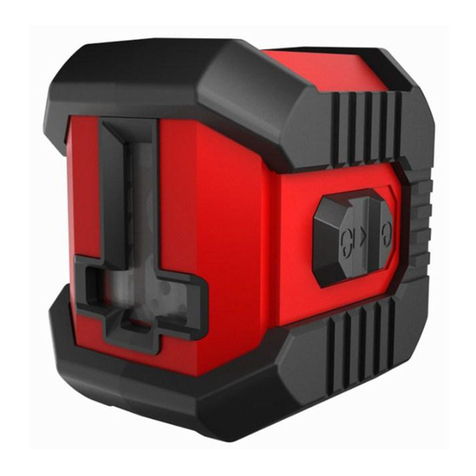
CONDTROL
CONDTROL Qb user manual
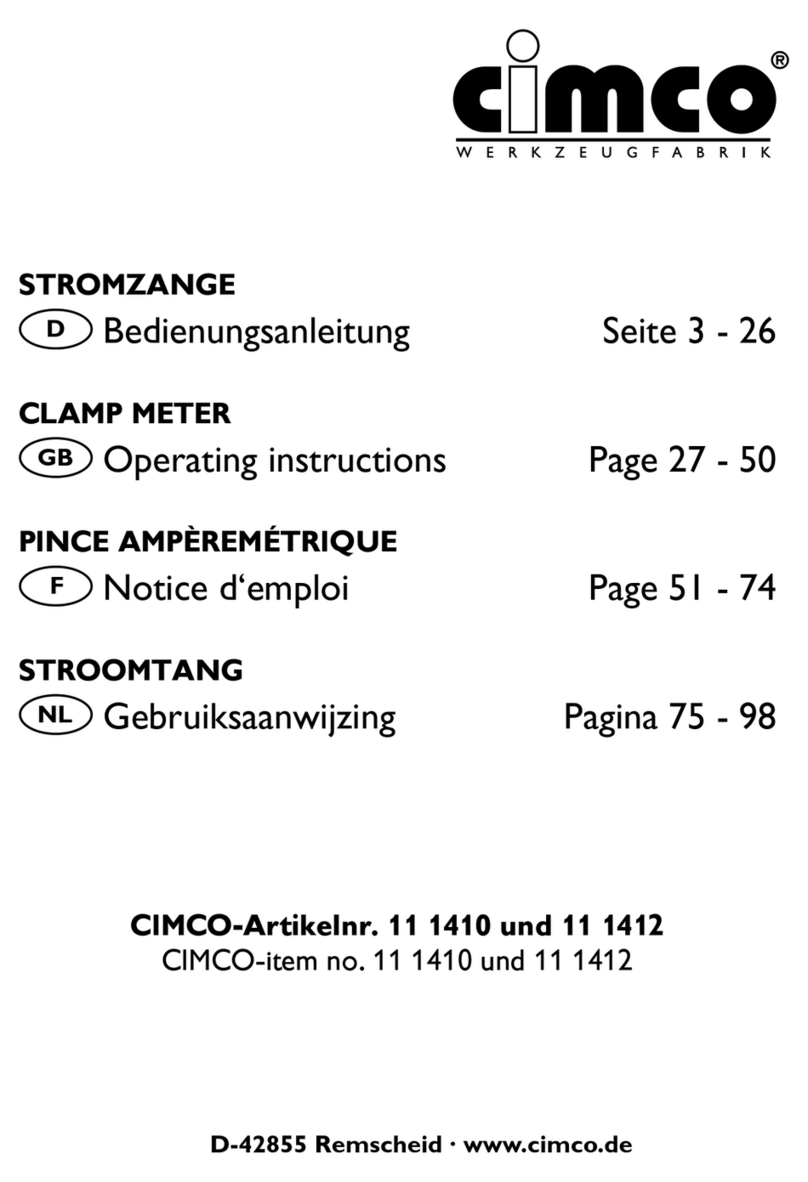
CIMCO
CIMCO 11 1410 operating instructions
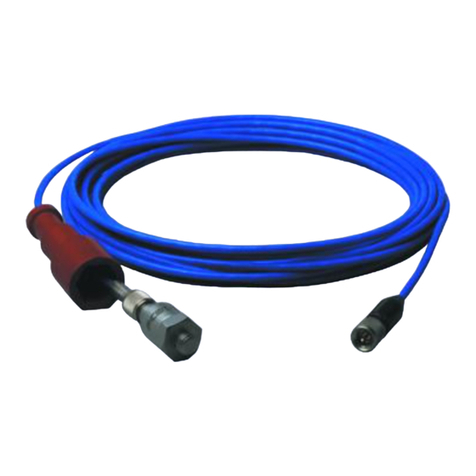
PCB Piezotronics
PCB Piezotronics 300A12 Installation and operating manual

Endress+Hauser
Endress+Hauser Cerabar S PMP71 Functional safety manual
